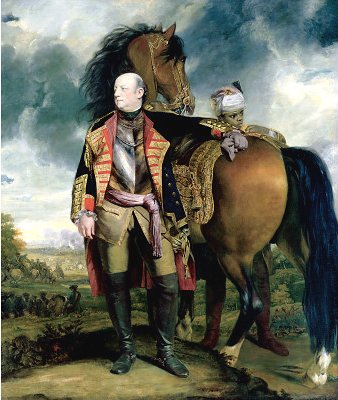 |
|
Portrait of John Manners, Marquis of Granby.
by Sir Joshua Reynolds (1723-1792)
by Josephine Fogg. Docent. April 11, 2000
Reynolds was one of the greatest English painters of the 18th century,
born in 1723. The painting is of John Manners, Marquis of Granby. Granby was the eldest
son of the Duke of Rutland. It was a tradition among the aristocracy in England that the
eldest son joined the army, the second son went into the church and the third son went to
the Colonies. Granby was a staunch supporter of the Hapsburgs. He raised his own regiment,
the Lincolnshire Blues and distinguished himself in several battles. He became a very
important general. Reynolds painted the Marquis looking out into the horizon. He painted a
separate portrait of the African manservant we can see behind the horse. If you look at
the left of the painting you can see an engagement of Calvary. Reynolds likes to paint
with a sense of grandeur and importance, which I think we can see with this painting.
Reynolds also liked to get to know his subjects with a view to bringing out their
character and their role in Society. Reynolds set this portrait in a battleground setting.
This portrait was painted as a gift from the Marquis to his adversary, French Marshal
Victor Francois.T |
Prior to Reynolds, the English aristocracy and landed gentry had preferred
the works of Italian and Dutch masters. He had been to Italy and had come to agree with
the connoisseurs of his time that the great masters of the Italian Renaissance, Raphael,
Michelangelo, Correggio and Titan were the exemplars of true art. He was also influenced
byRubens and studied their style. He believed in the superiority of History painting but
had to compromise and accept the fact that the art in demand was portraiture. He was
accepted in the Social life in London which gave him a large clientele. The grand houses
had large portrait galleries and were able to house paintings of this size.
This is a life-size full length portrait.
After he had established himself as an artist, Reynolds founded, along with Thomas
Gainsborough (on the opposite wall) the Royal Academy of Art in London. He became the
first President and was knighted. He believed that art could be taught if students were
given facilities for studying the recognized masterpieces. Gainsborough did not feel the
need to study the Italian Masters and was regarded as a natural genius. This painting was
the largest work painted by Gainsborough and has the reputation of being the finest
equestrian painting done by the Master. This portrait is of General Sir Philip Honywood.
Gainsboroughs first love was to paint landscapes. The beautiful landscape as the
background are the grounds of Sir Philip's estate, Marks Hall.
The Royal Academy is on Piccadilly in London and every year has a Summer Exhibition where
new painters and new art styles are sponsored. If you are able to visit London in the
Summer, make a point of visiting the Royal Academy and remember that John Ringling had the
foresight to purchase the work of two of the founders of this Academy. |
